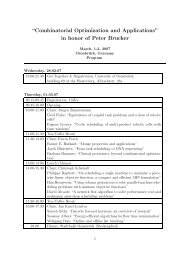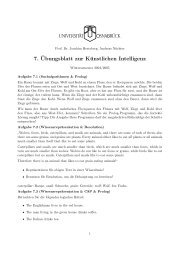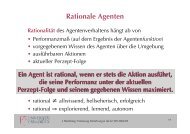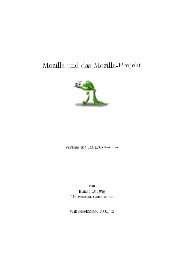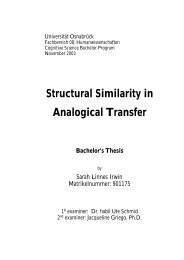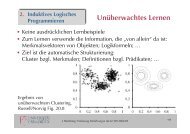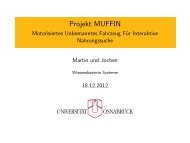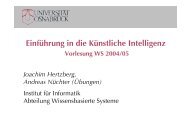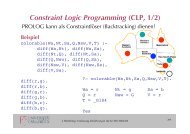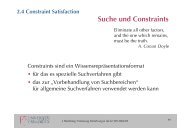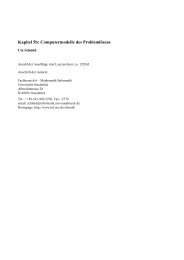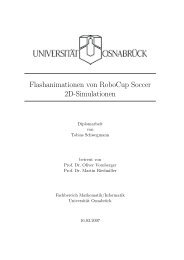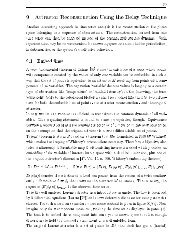Unsupervised Recursive Sequence Processing - Institute of ...
Unsupervised Recursive Sequence Processing - Institute of ...
Unsupervised Recursive Sequence Processing - Institute of ...
Create successful ePaper yourself
Turn your PDF publications into a flip-book with our unique Google optimized e-Paper software.
2 <strong>Unsupervised</strong> processing <strong>of</strong> sequences<br />
Let input sequences be denoted by s = (s 1 , . . . , s t ) with entries s i in an alphabet<br />
Σ which is embedded in a real-vector space R n . The element s 1 denotes the most<br />
recent entry <strong>of</strong> the sequence and t is the sequence length.The set <strong>of</strong> sequences <strong>of</strong><br />
arbitrary length over symbols Σ is Σ ∗ , and Σ l is the space <strong>of</strong> sequences <strong>of</strong> length l.<br />
Popular recursive sequence processing models are the temporal Kohonen map,<br />
recurrent SOM, recursive SOM, and SOM for structured data [8,11,39,41]. The<br />
SOMSD has originally been proposed for the more general case <strong>of</strong> tree structure<br />
processing. Here, only sequences, i.e. trees with a node fan-out <strong>of</strong> 1 are considered.<br />
As for standard SOM, a recursive neural map is given by a set <strong>of</strong> neurons n 1 , . . . ,<br />
n N . The neurons are arranged on a grid, <strong>of</strong>ten a two-dimensional regular lattice.<br />
All neurons are equipped with weights w i ∈ R n .<br />
Two important ingredients have to be defined to specify self-organizing network<br />
models: the data metric and the network update. The metric addressed the question,<br />
how an appropriate distance can be defined to measure the similarity <strong>of</strong> possibly<br />
sequential input signals to map units. For this purpose, the sequence entries<br />
are compared with the weight parameters stored at the neuron. The set <strong>of</strong> input signals<br />
for which a given neuron i is closest, is called the receptive field <strong>of</strong> neuron i,<br />
and neuron i is the winner and representative for all these signals within its receptive<br />
field. In the following, we will recall the distance computation for the standard<br />
SOM and also review several ways found in the literature to compute the distance<br />
<strong>of</strong> a neuron from a sequential input. Apart from the metric, the update procedure or<br />
learning rule for neurons to adapt to the input is essential. Commonly, Hebbian or<br />
competitive 1 learning takes place, referring to the following scheme: the parameters<br />
<strong>of</strong> the winner and its neighborhood within a given lattice structure are adapted<br />
such that their response to the current signal is increased. Thereby, neighborhood<br />
cooperation ensures a topologically faithful mapping.<br />
Standard SOM relies on a simple winner-takes-all scheme and does not account<br />
for the temporal structure <strong>of</strong> inputs. For a stimulus s i ∈ R n the neuron n j responds,<br />
for which the squared distance<br />
d SOM (s i , w j ) = ‖s i − w j ‖ 2 ,<br />
s i ∈ R n<br />
is minimum, where ‖ · ‖ is the standard Euclidean metric. Training starts with<br />
randomly initialized weights w i and adapts the parameters iteratively as follows:<br />
denote by n 0 the index <strong>of</strong> the winning neuron for the input signal s i . Assume a<br />
function nhd(n j , n k ) which indicates the degree <strong>of</strong> neighborhood <strong>of</strong> neuron j and<br />
k within the chosen lattice structure is fixed. Adaptation <strong>of</strong> all weights w j takes<br />
1 We will use these two terms interchangeably in the following.<br />
4





